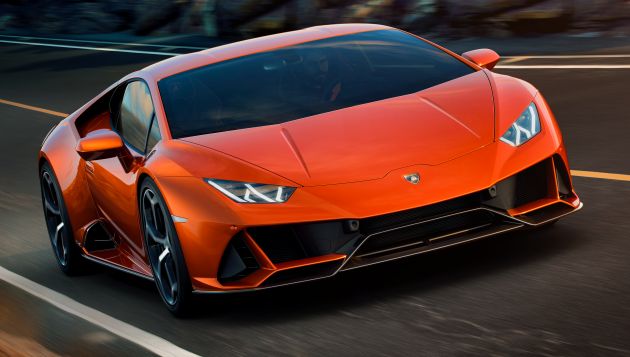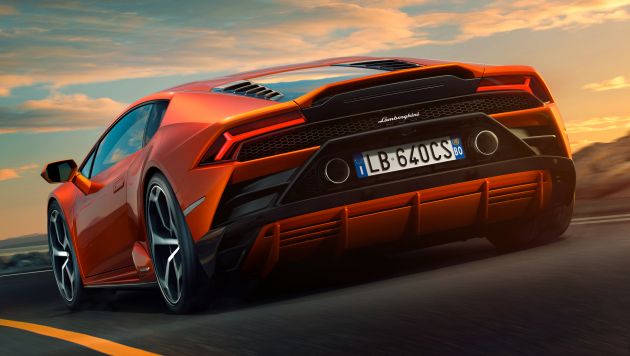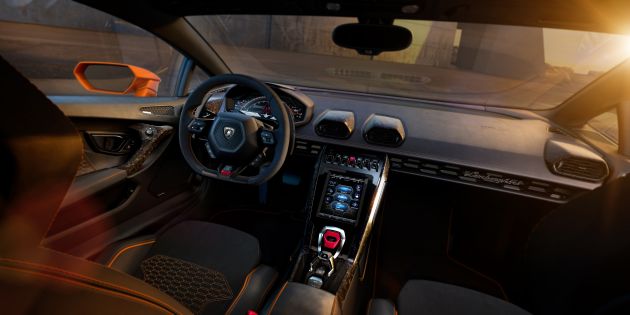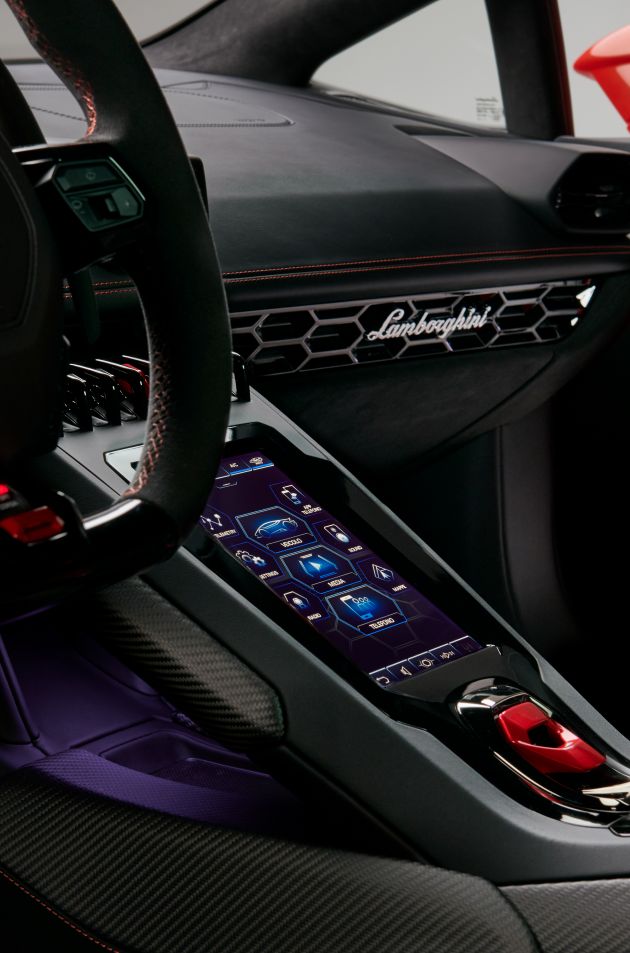Five years. That’s exactly how long the Lamborghini Huracán has been on the market, and since then it has sired numerous variations on the theme, including roadster, rear-wheel drive and hardcore Performante models. Now, the baby Lambo is set for a proper refresh, and the facelift – aptly dubbed Huracán Evo – takes the already potent engine and electronics and turns them up to 11.
In the case of the former, that means that Sant’Agata Bolognese has gone straight to the Performante’s parts bin, nicking its uprated 5.2 litre direct-injected, naturally-aspirated V10. This feral mill churns out a heady 640 hp at 8,000 rpm and 600 Nm of torque at 6,500 rpm, and as before all that power is pushed to all four wheels through a seven-speed dual-clutch transmission.
So equipped, the Evo whips from zero to 100 km/h in just 2.9 seconds – identical to the Performante despite being 40 kg heavier at 1,422 kg, the same dry weight as its predecessor. It will then run on to 200 km/h in a blistering 9.0 seconds, a measly 0.1 seconds behind its lightweight sibling. The top speed is quoted at over 325 km/h, and it will brake from 100 km/h to a dead stop in just 31.9 metres.
The biggest party piece, however, is the Lamborghini Dinamica Veicolo Integrata (LDVI), a central processing unit that not only integrates and controls all of the car’s electronics, but also predicts the driver’s next move and needs, adjusting the car’s setup to suit.
Central to all of this is version 2.0 of the Performante’s Lamborghini Piattaforma Inerziale (LPI), a group of accelerometers and gyroscope sensors placed at the car’s centre of gravity. Now more precise, it measures dynamic vehicle attitude through lateral, longitudinal and vertical acceleration, as well as roll, pitch and yaw rate in real time. The magneto rheological dampers have also been upgraded and work in tandem with LPI.
Elsewhere, the new, more advanced traction control system, together with the enhanced all-wheel drive system and torque vectoring, allows traction to be directed to a single wheel as required. Most importantly, the Evo now gets rear-wheel steering which, combined with the more responsive Lamborghini Dynamic Steering (LDS), enhances low-speed agility and high-speed cornering and braking stability.
All this, says Lamborghini, has turned the Huracán into a super agile and responsive vehicle with unparalleled level of control, the LDVI being able to recognise the driver’s intentions in real time through steering, brake and throttle inputs, along with the selected gear and the driving mode (Strada, Sport or Corsa) activated via the Anima controller.
The car can even determine road conditions through the active suspension and by estimating the grip from the all-wheel drive system. From there, it will not just react but predict the best driving setup for the next moment, thanks to the “feed forward” logic in the dynamic controller. It’s artificial intelligence, basically – only instead of driving the car for you, it will help you make mincemeat of the road ahead.
This is all backed by a comprehensive redesign that increases the aerodynamic efficiency and ramps up the aggressiveness of the already mean-looking outgoing model. The front end now gets Y-shaped air intakes, plus a splitter and integrated wing that, in our eyes, makes the Huracán look like it’s wearing a bull bar. The Y shape is also found on the new 20-inch Aesir wheels, and the side air intakes have been reshaped too.
It’s at the rear where the Evo borrows most heavily from the Performante style-wise, aping the latter’s numerous slats and vents, plus the raised twin outlets of its new sports exhaust system. Unlike the Performante, the Evo isn’t fitted with a physics-bending Aerodinamica Lamborghini Attiva (ALA) active aero system or a trick rear wing – instead, it gets a simple integrated, slotted spoiler to enhance air flow.
Meanwhile, the underbody has been reshaped, again to maximise aerodynamic efficiency, and the net result is that the Evo has more than five times the downforce and aero efficiency of the original Huracán. The new car also debuts a new colour for Lamborghini, the four-layer Arancio Xanto orange, and can be customised via new options such as the black or body-coloured Style Packs, as well as the Ad Personam programme.
Inside, the old car’s button-laden centre stack has been replaced by a new 8.4-inch capacitive touchscreen with multi-finger gesture control, operating the seats, climate control, infotainment (including Apple CarPlay) and the LDVI system status.
There’s also a multimedia system with connected navigation and entertainment, voice commands (including Siri) and an optional dual-camera telemetry system and integrated high-capacity hard disk. The colour and trim palette has also been expanded with a unique Alcantara and leather upholstery with Arancio Dryope highlights to match the new exterior hue, along with customisable ambient lighting.
Source: Read Full Article




